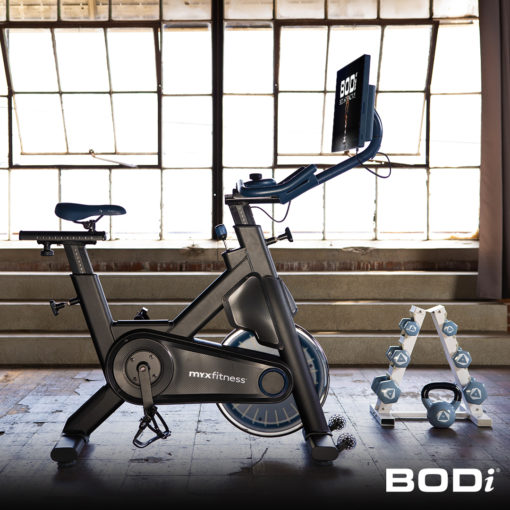Interval running is great for fitness because it is a highly effective training protocol and it’s useful for both beginners and experienced runners. “An interval is simply a set period of time where you are running at a certain pace and then taking a break for a certain period of time,” Todd Buckingham, Ph.D explains. Scroll down to read the rest of this post from Jenessa Connor, CPT in the Beachbody On Demand Blog.

If you’re new to running, it may surprise you just how many types of running workouts exist.
There’s the tempo run, the fartlek, hill repeats, striders, and, of course, interval running.
No matter what running program you follow, you’re bound to see a handful of these workouts, and for good reason.
Interval running is a highly effective training protocol, and it’s useful for both beginners and experienced runners.
Curious about how to incorporate this type of running into your current fitness routine? Here’s everything you need to know.
What Is Interval Running?
One common misconception about interval running is that it must include fast, high-intensity running, says Todd Buckingham, Ph.D., an exercise physiologist at Mary Free Bed Sports Rehabilitation Performance Lab in Wyoming, Michigan.
“An interval is simply a set period of time where you are running at a certain pace and then taking a break for a certain period of time,” he explains.
Intervals can be slow, moderately paced, or fast.
“This could be 30 seconds for an all-out sprint followed by 30 seconds of rest, or it could be a 10-minute interval at tempo pace followed by a two-minute jog,” he says.
These workouts are appropriate for beginners and experienced runners alike, as the intensity and duration of the intervals can be adjusted accordingly.
Benefits of Interval Running
Considering running is one of the most straightforward, set-it-and-forget-it forms of exercise, why complicate things with varying paces?
What are the benefits of doing so?
1. Interval running is beginner-friendly
For beginners, interval running workouts may feel more accessible than going out for a steady-state run, says Steve Carmichael, a USA Track and Field and RRCA certified running coach.
“When a new runner starts, they often struggle to keep running without stopping,” he says. “Interval training allows a runner to work their way up to continue running in a progressive manner.”
It may also help prevent running injuries.
“Interval running helps new runners take time to adapt to the rigors and impact of running as their muscles and bones adapt to the new activity,” Carmichael explains.
2. Interval running is efficient
Good news if you’re short on time: You can get a lot done in just a few, quick intervals — if you work really hard during them.
In one research study, 15 active women did three interval running workouts a week for six weeks.
Each workout consisted of no more than six 30-second “all-out” sprints followed by four minutes of rest.
(At most, participants ran for a total of three minutes per workout.)
According to the study, this training protocol decreased body fat mass by 8.0% and waist circumference by 3.5%.
It also increased maximal oxygen consumption by 8.7% and peak running speed by 4.8%.
3. Interval Running Increases Speed and Builds Endurance
It’s not easy to build endurance, especially for new runners, says Carmichael.
“Endurance is best trained at lower heart rate zones — zone 2 and 3,” he explains. “New runners often struggle with keeping their heart rate in the lower zones as their cardiovascular system is still developing. [low to moderate intensity] interval running can help keep the heart rate from getting too high, thus assisting with the development of endurance.”
For more experienced runners, it has been shown to improve speed and overall performance.
“The body learns to adapt to a faster pace both at an aerobic/anaerobic level as well as a neuromuscular level,” Carmichael adds. “The recovery cycle (the easy pace or walking pace) allows the runner to ‘recover’ their oxygen deficit and prepare themselves for the next speed interval.”
4. Interval running trains your brain
Anyone who’s ever run a mile knows that the mental aspect of running is just as important as the physicality of it.
When the course is rough and the miles are long, it can be easy to let self-doubt and fear take over.
Karina Krepp, certified running coach with New York Road Runners in New York City, says interval running offers an opportunity to listen to our thoughts when things get hard.
“Whenever we move outside our comfort zone we have a whole slew of thoughts that may not be very helpful to our overall goals,” she says.
“When doing these short bites of hard work, you can witness your self-talk during the hard parts. If I’m being really hard on myself I’ll also ask myself, ‘Would you say that to someone else?’ Most of the sport is supported by making friends with your mind,” Krepp explains.
5. Interval running is more fun
Research shows that this type of running may be more enjoyable than running at a consistent pace.
In one study, eight men performed two different running protocols: a high-intensity interval running workout and a 50-minute moderate-intensity run.
The participants’ rating of perceived enjoyment associated with the interval running workout was significantly higher than that of the moderate-intensity run despite higher ratings of perceived exertion.
So if you’ve always found running to be a bit of a slog, a few fast intervals might keep you engaged.
How to Add Interval Running in Your Training Routine
The number one tip for incorporating this type of running into your training? Start slow.
“High-intensity intervals will be a shock to the system if you have never done them before and can cause more muscle damage than a normal easy run,” Buckingham says. “This means that it will take longer to recover, and you will be more sore after your run. Progress slowly by starting with a low number of repetitions and a short duration for each interval with a long recovery interval between.”
Following a guided running program like 30 Day Breakaway with track-and-field athlete and Super Trainer Idalis Velazquez can help ensure you progress gradually while continually challenging yourself.
30 Day Breakaway, which combines running and resistance training, allows you to select a training calendar based on your current fitness level.
So, whether you’re hoping to run your first 5k, shave time off your PR, or just get in shape, 30 Day Breakaway will get you to your goal.
Create a free Beachbody On Demand account and find out how Beachbody’s at-home workouts, nutrition programs, and online community work together to help you reach your health and fitness goals.





